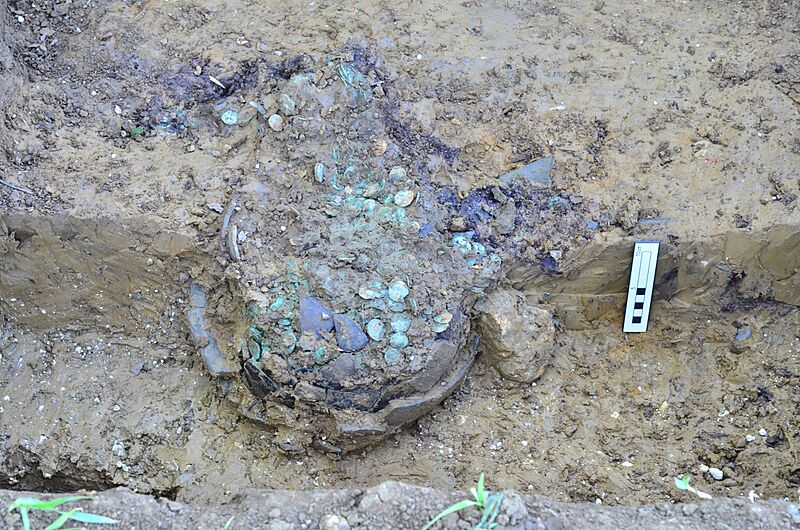Image: Huntingdon, Cambridgeshire "Muddy" Hoard 2018

Description: "A partially disturbed hoard of Roman coins discovered whilst the finder was metal-detecting on cultivated land. The initial discovery of a scatter of coins was thought to be a hoard and so it was left in-situ (following good practice) while the discovery was reported to the Finds Liaison Officer for Cambridgeshire, Helen Fowler. The hoard was then excavated by Helen Fowler and Dr. Andrew Brown of the British Museum. The hoard was contained within at least two Roman ceramic vessels, one inside the other and had been partly disturbed by the action of roots and agricultural machinery but was mostly still in situ. No surviving archaeological feature containing the hoard was detected. A larger, coarser grey ware vessel was on the outside and within it was a finer, dark grey vessel that contained the coins. The coins were removed from the pot in three main layers. After excavation the hoard was brought to the British Museum for conservation under the supervision of Pippa Pearce. The coins were given an initial sort by the subdivisions in which they were received (layers and other smaller groups by context). The totals by emperor were then analysed but the composition of the hoard was found to be homogenous with no discernible patterning in the distribution of coins within the vessel. The coins were therefore amalgamated before being fully catalogued. All but three of the 9724 Roman coins in the hoard are of the denomination known (to modern scholarship) as radiates, originally a silver multiple of the better known Roman denarius but by this period predominantly base metal in composition. There are three contemporary denarii in the hoard – by this time also debased. The coins range in date from AD 251–74 and the assemblage is broadly similar in composition to the many Romano-British coin hoards buried in the aftermath of the breakaway ‘Gallic Empire’. The Gallic Empire, whose capital was at the city of Trier but which had held dominion over Britain, was established in AD 260 and reconquered by the legitimate (‘central’) Emperor Aurelian (AD 270–5) in AD 274 from the final Gallic rulers Tetricus I (AD 271–4) and his young son Tetricus II. The hoard is notable for having a high proportion of contemporary imitations in the group. These are copies of radiates circulating in the mid AD 270s and are likely to have been made at the time of or in the decade following the reigns of the Tetrici when the official coinage was in short supply following the coin reforms of Aurelian. So-called ‘barbarous radiates’ are often very crude copies of smaller module but the imitations in this hoard are of similar module to contemporary coins and of varied quality. It is likely that these were issued towards the beginning of the period and no coins with prototypes post-dating Tetricus II have been identified. Some of the regular coinage of Claudius II and Gallienus in the hoard is of poorer fabric and it is likely that some of these are also good imitations."
Title: Huntingdon, Cambridgeshire "Muddy" Hoard 2018
Credit: https://finds.org.uk/database/artefacts/record/id/901810/recordtype/artefacts
Author: Helen Fowler
Usage Terms: Creative Commons Attribution-Share Alike 4.0
License: CC BY-SA 4.0
License Link: https://creativecommons.org/licenses/by-sa/4.0
Attribution Required?: Yes
Image usage
The following page links to this image:

